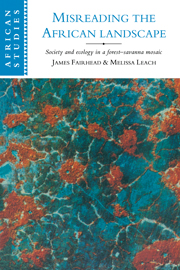Book contents
- Frontmatter
- Contents
- List of plates
- List of figures
- List of tables
- Note on authorship and research collaboration
- Acknowledgements
- Linguistic conventions
- Introduction
- 1 Convictions of forest loss in policy and ecological science
- 2 Forest gain: historical evidence of vegetation change
- 3 Settling a landscape: forest islands in regional social and political history
- 4 Ecology and society in a Kuranko village
- 5 Ecology and society in a Kissi village
- 6 Enriching a landscape: working with ecology and deflecting successions
- 7 Accounting for forest gain: local land use, regional political economy and demography
- 8 Reading forest history backwards: a century of environmental policy
- 9 Sustaining reversed histories: the continual production of views of forest loss
- 10 Towards a new forest–savanna ecology and history
- Appendix I Glossary of plant names
- Appendix II Cassette recordings of oral accounts and discussions
- Notes
- List of references
- Index
- Titles in the series
- Plate section
4 - Ecology and society in a Kuranko village
Published online by Cambridge University Press: 05 June 2012
- Frontmatter
- Contents
- List of plates
- List of figures
- List of tables
- Note on authorship and research collaboration
- Acknowledgements
- Linguistic conventions
- Introduction
- 1 Convictions of forest loss in policy and ecological science
- 2 Forest gain: historical evidence of vegetation change
- 3 Settling a landscape: forest islands in regional social and political history
- 4 Ecology and society in a Kuranko village
- 5 Ecology and society in a Kissi village
- 6 Enriching a landscape: working with ecology and deflecting successions
- 7 Accounting for forest gain: local land use, regional political economy and demography
- 8 Reading forest history backwards: a century of environmental policy
- 9 Sustaining reversed histories: the continual production of views of forest loss
- 10 Towards a new forest–savanna ecology and history
- Appendix I Glossary of plant names
- Appendix II Cassette recordings of oral accounts and discussions
- Notes
- List of references
- Index
- Titles in the series
- Plate section
Summary
Three trucks leave Kissidougou each week for the Friday market at Baleya, 60 km west along the dirt track to Sierra Leone. They barely halt at Sandaya. Their route through the sparsely wooded savannas is punctuated by the shade of the forest islands of first Kissi, then Lele and now Kuranko villages. They then leave behind Foria, the modern headquarters of the administrative district which roughly coincides with the old Kuranko territory (yamana) of Koundou. And when they descend to cross the gallery-forested Manwalsa stream, they are already in the village territory of Sandaya (figure 4.1), 28 km from the town. The village comes as a surprise, unheralded by a mature forest island. Like many villages, Sandaya moved to the roadside in the late 1950s. The belts of woodland developing around the village do not yet stand out from afar.
The village (so) is split by a stream. On the higher land either side, round, mud-walled, thatched houses form distinct groups around courtyards; each the compound (lu) of those related to a particular patrilineage. Behind those houses on the village perimeter, fenced gardens stretch back to border on the young forest which is developing. A network of paths radiates from the village and into its territory. One leads south over the savannas, and then, crossing the river Niandan, reaches Lokongo, a village in the Silankolo yamana of Lele country; the parental home of many women married in Sandaya, and the present home of many of its daughters.
- Type
- Chapter
- Information
- Misreading the African LandscapeSociety and Ecology in a Forest-Savanna Mosaic, pp. 115 - 148Publisher: Cambridge University PressPrint publication year: 1996



